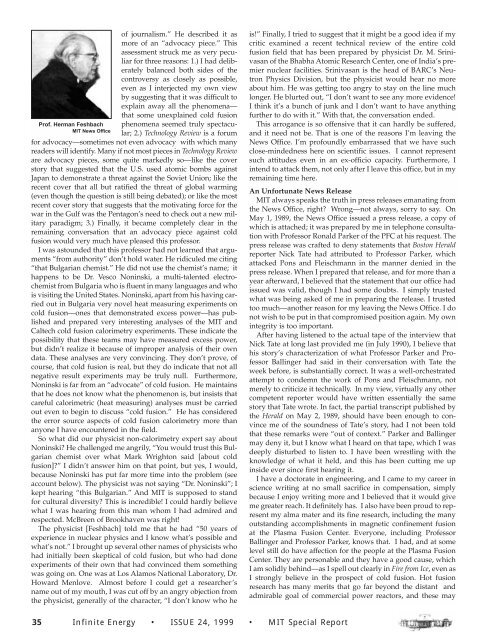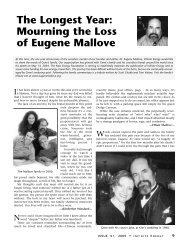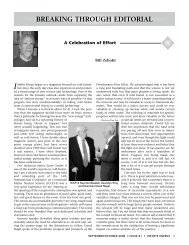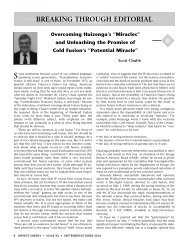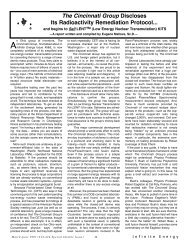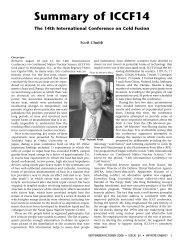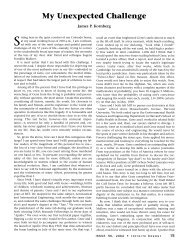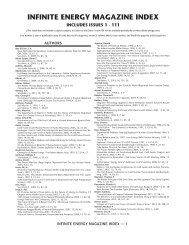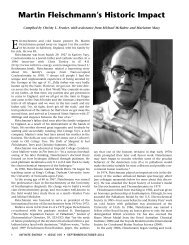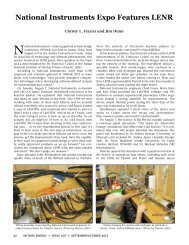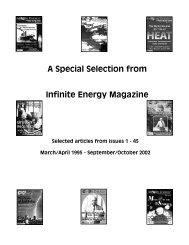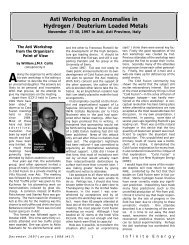MIT and Cold Fusion: A Special Report - Infinite Energy Magazine
MIT and Cold Fusion: A Special Report - Infinite Energy Magazine
MIT and Cold Fusion: A Special Report - Infinite Energy Magazine
You also want an ePaper? Increase the reach of your titles
YUMPU automatically turns print PDFs into web optimized ePapers that Google loves.
Prof. Herman Feshbach<br />
<strong>MIT</strong> News Office<br />
of journalism.” He described it as<br />
more of an “advocacy piece.” This<br />
assessment struck me as very peculiar<br />
for three reasons: 1.) I had deliberately<br />
balanced both sides of the<br />
controversy as closely as possible,<br />
even as I interjected my own view<br />
by suggesting that it was difficult to<br />
explain away all the phenomena—<br />
that some unexplained cold fusion<br />
phenomena seemed truly spectacular;<br />
2.) Technology Review is a forum<br />
for advocacy—sometimes not even advocacy with which many<br />
readers will identify. Many if not most pieces in Technology Review<br />
are advocacy pieces, some quite markedly so—like the cover<br />
story that suggested that the U.S. used atomic bombs against<br />
Japan to demonstrate a threat against the Soviet Union; like the<br />
recent cover that all but ratified the threat of global warming<br />
(even though the question is still being debated); or like the most<br />
recent cover story that suggests that the motivating force for the<br />
war in the Gulf was the Pentagon’s need to check out a new military<br />
paradigm; 3.) Finally, it became completely clear in the<br />
remaining conversation that an advocacy piece against cold<br />
fusion would very much have pleased this professor.<br />
I was astounded that this professor had not learned that arguments<br />
“from authority” don’t hold water. He ridiculed me citing<br />
“that Bulgarian chemist.” He did not use the chemist’s name; it<br />
happens to be Dr. Vesco Noninski, a multi-talented electrochemist<br />
from Bulgaria who is fluent in many languages <strong>and</strong> who<br />
is visiting the United States. Noninski, apart from his having carried<br />
out in Bulgaria very novel heat measuring experiments on<br />
cold fusion—ones that demonstrated excess power—has published<br />
<strong>and</strong> prepared very interesting analyses of the <strong>MIT</strong> <strong>and</strong><br />
Caltech cold fusion calorimetry experiments. These indicate the<br />
possibility that these teams may have measured excess power,<br />
but didn’t realize it because of improper analysis of their own<br />
data. These analyses are very convincing. They don’t prove, of<br />
course, that cold fusion is real, but they do indicate that not all<br />
negative result experiments may be truly null. Furthermore,<br />
Noninski is far from an “advocate” of cold fusion. He maintains<br />
that he does not know what the phenomenon is, but insists that<br />
careful calorimetric (heat measuring) analyses must be carried<br />
out even to begin to discuss “cold fusion.” He has considered<br />
the error source aspects of cold fusion calorimetry more than<br />
anyone I have encountered in the field.<br />
So what did our physicist non-calorimetry expert say about<br />
Noninski? He challenged me angrily, “You would trust this Bulgarian<br />
chemist over what Mark Wrighton said [about cold<br />
fusion]?” I didn’t answer him on that point, but yes, I would,<br />
because Noninski has put far more time into the problem (see<br />
account below). The physicist was not saying “Dr. Noninski”; I<br />
kept hearing “this Bulgarian.” And <strong>MIT</strong> is supposed to st<strong>and</strong><br />
for cultural diversity? This is incredible! I could hardly believe<br />
what I was hearing from this man whom I had admired <strong>and</strong><br />
respected. McBreen of Brookhaven was right!<br />
The physicist [Feshbach] told me that he had “50 years of<br />
experience in nuclear physics <strong>and</strong> I know what’s possible <strong>and</strong><br />
what’s not.” I brought up several other names of physicists who<br />
had initially been skeptical of cold fusion, but who had done<br />
experiments of their own that had convinced them something<br />
was going on. One was at Los Alamos National Laboratory, Dr.<br />
Howard Menlove. Almost before I could get a researcher’s<br />
name out of my mouth, I was cut off by an angry objection from<br />
the physicist, generally of the character, “I don’t know who he<br />
is!” Finally, I tried to suggest that it might be a good idea if my<br />
critic examined a recent technical review of the entire cold<br />
fusion field that has been prepared by physicist Dr. M. Srinivasan<br />
of the Bhabha Atomic Research Center, one of India’s premier<br />
nuclear facilities. Srinivasan is the head of BARC’s Neutron<br />
Physics Division, but the physicist would hear no more<br />
about him. He was getting too angry to stay on the line much<br />
longer. He blurted out, “I don’t want to see any more evidence!<br />
I think it’s a bunch of junk <strong>and</strong> I don’t want to have anything<br />
further to do with it.” With that, the conversation ended.<br />
This arrogance is so offensive that it can hardly be suffered,<br />
<strong>and</strong> it need not be. That is one of the reasons I’m leaving the<br />
News Office. I’m profoundly embarrassed that we have such<br />
close-mindedness here on scientific issues. I cannot represent<br />
such attitudes even in an ex-officio capacity. Furthermore, I<br />
intend to attack them, not only after I leave this office, but in my<br />
remaining time here.<br />
An Unfortunate News Release<br />
<strong>MIT</strong> always speaks the truth in press releases emanating from<br />
the News Office, right? Wrong—not always, sorry to say. On<br />
May 1, 1989, the News Office issued a press release, a copy of<br />
which is attached; it was prepared by me in telephone consultation<br />
with Professor Ronald Parker of the PFC at his request. The<br />
press release was crafted to deny statements that Boston Herald<br />
reporter Nick Tate had attributed to Professor Parker, which<br />
attacked Pons <strong>and</strong> Fleischmann in the manner denied in the<br />
press release. When I prepared that release, <strong>and</strong> for more than a<br />
year afterward, I believed that the statement that our office had<br />
issued was valid, though I had some doubts. I simply trusted<br />
what was being asked of me in preparing the release. I trusted<br />
too much—another reason for my leaving the News Office. I do<br />
not wish to be put in that compromised position again. My own<br />
integrity is too important.<br />
After having listened to the actual tape of the interview that<br />
Nick Tate at long last provided me (in July 1990), I believe that<br />
his story’s characterization of what Professor Parker <strong>and</strong> Professor<br />
Ballinger had said in their conversation with Tate the<br />
week before, is substantially correct. It was a well-orchestrated<br />
attempt to condemn the work of Pons <strong>and</strong> Fleischmann, not<br />
merely to criticize it technically. In my view, virtually any other<br />
competent reporter would have written essentially the same<br />
story that Tate wrote. In fact, the partial transcript published by<br />
the Herald on May 2, 1989, should have been enough to convince<br />
me of the soundness of Tate’s story, had I not been told<br />
that these remarks were “out of context.” Parker <strong>and</strong> Ballinger<br />
may deny it, but I know what I heard on that tape, which I was<br />
deeply disturbed to listen to. I have been wrestling with the<br />
knowledge of what it held, <strong>and</strong> this has been cutting me up<br />
inside ever since first hearing it.<br />
I have a doctorate in engineering, <strong>and</strong> I came to my career in<br />
science writing at no small sacrifice in compensation, simply<br />
because I enjoy writing more <strong>and</strong> I believed that it would give<br />
me greater reach. It definitely has. I also have been proud to represent<br />
my alma mater <strong>and</strong> its fine research, including the many<br />
outst<strong>and</strong>ing accomplishments in magnetic confinement fusion<br />
at the Plasma <strong>Fusion</strong> Center. Everyone, including Professor<br />
Ballinger <strong>and</strong> Professor Parker, knows that. I had, <strong>and</strong> at some<br />
level still do have affection for the people at the Plasma <strong>Fusion</strong><br />
Center. They are personable <strong>and</strong> they have a good cause, which<br />
I am solidly behind—as I spell out clearly in Fire from Ice, even as<br />
I strongly believe in the prospect of cold fusion. Hot fusion<br />
research has many merits that go far beyond the distant <strong>and</strong><br />
admirable goal of commercial power reactors, <strong>and</strong> these may<br />
35 <strong>Infinite</strong> <strong>Energy</strong> • ISSUE 24, 1999 • <strong>MIT</strong> <strong>Special</strong> <strong>Report</strong>


